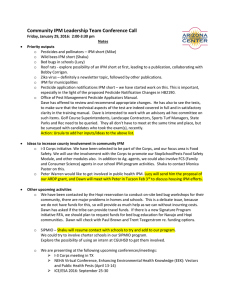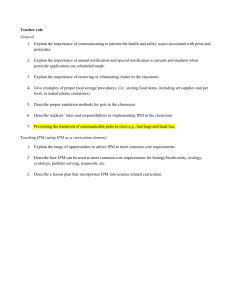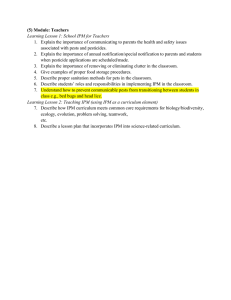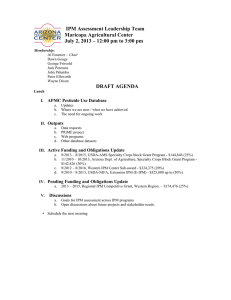Community IPM Leadership Team Meeting
advertisement
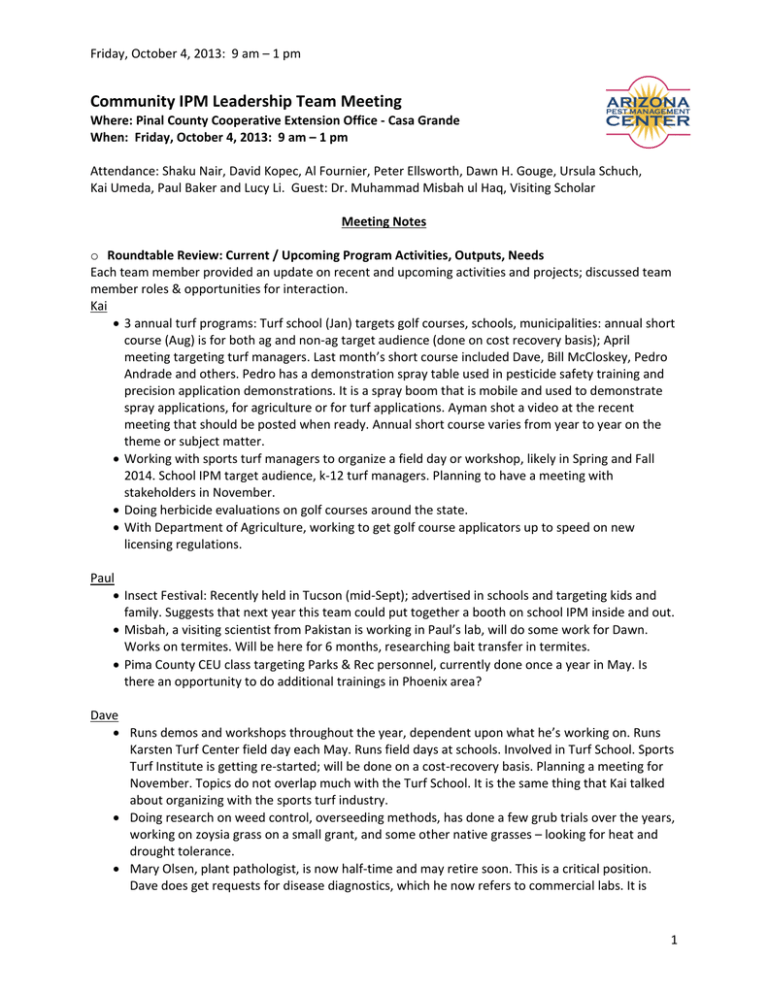
Friday, October 4, 2013: 9 am – 1 pm Community IPM Leadership Team Meeting Where: Pinal County Cooperative Extension Office - Casa Grande When: Friday, October 4, 2013: 9 am – 1 pm Attendance: Shaku Nair, David Kopec, Al Fournier, Peter Ellsworth, Dawn H. Gouge, Ursula Schuch, Kai Umeda, Paul Baker and Lucy Li. Guest: Dr. Muhammad Misbah ul Haq, Visiting Scholar Meeting Notes o Roundtable Review: Current / Upcoming Program Activities, Outputs, Needs Each team member provided an update on recent and upcoming activities and projects; discussed team member roles & opportunities for interaction. Kai 3 annual turf programs: Turf school (Jan) targets golf courses, schools, municipalities: annual short course (Aug) is for both ag and non-ag target audience (done on cost recovery basis); April meeting targeting turf managers. Last month’s short course included Dave, Bill McCloskey, Pedro Andrade and others. Pedro has a demonstration spray table used in pesticide safety training and precision application demonstrations. It is a spray boom that is mobile and used to demonstrate spray applications, for agriculture or for turf applications. Ayman shot a video at the recent meeting that should be posted when ready. Annual short course varies from year to year on the theme or subject matter. Working with sports turf managers to organize a field day or workshop, likely in Spring and Fall 2014. School IPM target audience, k-12 turf managers. Planning to have a meeting with stakeholders in November. Doing herbicide evaluations on golf courses around the state. With Department of Agriculture, working to get golf course applicators up to speed on new licensing regulations. Paul Insect Festival: Recently held in Tucson (mid-Sept); advertised in schools and targeting kids and family. Suggests that next year this team could put together a booth on school IPM inside and out. Misbah, a visiting scientist from Pakistan is working in Paul’s lab, will do some work for Dawn. Works on termites. Will be here for 6 months, researching bait transfer in termites. Pima County CEU class targeting Parks & Rec personnel, currently done once a year in May. Is there an opportunity to do additional trainings in Phoenix area? Dave Runs demos and workshops throughout the year, dependent upon what he’s working on. Runs Karsten Turf Center field day each May. Runs field days at schools. Involved in Turf School. Sports Turf Institute is getting re-started; will be done on a cost-recovery basis. Planning a meeting for November. Topics do not overlap much with the Turf School. It is the same thing that Kai talked about organizing with the sports turf industry. Doing research on weed control, overseeding methods, has done a few grub trials over the years, working on zoysia grass on a small grant, and some other native grasses – looking for heat and drought tolerance. Mary Olsen, plant pathologist, is now half-time and may retire soon. This is a critical position. Dave does get requests for disease diagnostics, which he now refers to commercial labs. It is 1 Friday, October 4, 2013: 9 am – 1 pm important to try to document the number of requests we are getting for the APMC, for reporting purposes but also to support grant applications. Ursula Desert Hort Conference every May. 240 attendees this year, down from 500 people a few years ago. Targets landscape maintenance personnel, primarily. Dave and many others have been involved. There is a desire for hands-on training; she did a workshop track this year, limited to about 25 participants. October 25 field day 9-noon at MAC to demonstrate results of multi-year irrigation experiment. Capped at 50 participants. Advertising through Desert Hort listserve. Next week it will go out through Smartscape listserve. Experiment is on-going. Diverse funding sources: TRIF program, AZ Forestry Dept, others Doing some pomegranate research funded through a grant, in Tucson, Yuma and Bowie. Having pest problems with ground squirrels and birds at some sites. Will do taste tests. Tilak is managing the plots. Research question: What can homeowners and commercial growers grow in different areas of Arizona? ADA Specialty Crop Block Grant. Extension project: using hoop houses to grow produce, working with underserved audiences. She has a grad student working on research related to this: conventional versus organic production. Had problems with ground squirrels and ants. Collecting data on crop management, costs, economic analysis. Did soil solarization research in the summer. Dawn: She is on the National Steering Committee for School IPM; EPA wants to fund work in 2 states with no school IPM programs: possibly in the south. The Steering Committee argues that you need to have someone local or piggyback on other projects. Peter suggested dialog with the Southern IPM Center and the IPM Coordinators in the state. EPA has a committee on this project that meets 3 times per month. Dawn sits on EPA pesticide program dialog committee – subcommittee on community IPM. Involved in IPM in housing. Interest on campus on developing a survey on how college students respond to spiders. This survey has been done in 4 other states. Has a grad student, Christopher Bibbs, working on bark scorpions in school environment. Learning a lot about scorpion movement. Examining harborage preferences. The goal is to develop recommendations on how to modify environments to limit scorpion infestations. Planning studies on bed bugs and entomopathogenic nematodes – just for fun. Lucy: Invited to present on bed bugs to Inter-tribal Council, included 20 Indian tribes. Very positive feedback from participants. Some tribal school personnel expressed an interest in the program. Tribal health departments also interested in future work. EPA Region 9 was involved, and people there were impressed (future funding source?) Went to Maricopa Unified School District – will cover below. Published an article about mosquitoes in Journal of Medical Entomology. Article on scabies in newsletter and meet with school nurses on Nov 20 about this topic. Had requests to do head lice training with tribes (Ak-Chin). 2 Friday, October 4, 2013: 9 am – 1 pm Lucy and Shaku working as collaborators in the project “Certification/Certificate for IPM Roles in Schools and Sensitive Environments”. This experience will greatly help us with our EPA School IPM grant implementation, if it gets funded. She is revising a comprehensive Extension publication on mosquitos, biology, control prevention. She has finished a revised draft. Conducting online bed bug survey which is IRB approved and has recently been pilot tested. Send the link to Paul. Bed bug information for low-literacy users recently finished. Will be distributed to public housing and low income audiences. It is online. They do not have funding for a printed version. Has not been submitted for review and publication in Extension. Possible WIPMC publications grant? It has been tested minimally with the intended audience. It will be developed into a presentation for workshops. Suggestion: do a pre-and-post evaluation. Dawn: we always do this. Send a draft to the group for review. Peter o Highlands Master Gardening: Peter will be presenting on biotechnology. Chris Jones is organizing it. Has a pest presentation from Tess Grasswitz from NM. This group needs to develop a profile within cooperative extension so that people are more aware of this group as a resource. Think about ways to get the word about what this leadership team is and what we do (for example, Arizona Agricultural Extension Agents) o School IPM Inside and Out: Implementation Project Update & Plans Review of Steps / Game Plan for Engagement with Districts Initial agreement (a letter of introduction, what to expect, MOU: put something in writing); initial assessment (in, out); report/recommendations, school district response to recommendations; training plan; follow-up interviews; 1-year assessment Do we have a draft a letter that outlines the program and a timetable and who is responsible for what, access to records? Is there a draft template that includes this among Bryan’s files? Either way we need to draft something and get input from team members. Should everyone attend the initial assessment? It is good to have as many as possible, but as long as we have expertise from each area involved. Evaluation data: Interview guide revisions, follow-up questions, pesticide use data, photographic comparisons, clutter index Follow up questions: Al shared 2 new open-ended questions he and Shaku wrote to add to the Interview Guide, to measure outcomes within the implementation school and across the district. Comment: Open-ended questions are good. But add scale questions on specific topics related to IPM outcomes and their own identified goals. Results will guide us as to how we improve each program internally. Work with schools that we have engaged so far: what are their perceptions of success. What can we learn from what we did with other school districts? Current Status (Shaku/Ursula/Dawn) Phoenix Union High School District – Dawn has contacted Tony Scarfo; they would like to continue. We have 2 years of pesticide application records (both indoor and outdoor). From Bryan’s file, a “check-up” as done after about 5 months. Gilbert Unified School District Dawn made contact with Dave Lee (does structural pest management internally in the district) and they are interested to continue with the program, but they have not 3 Friday, October 4, 2013: 9 am – 1 pm provided access to pesticide application records. They claim they only do spot treatments indoors (no contractors), and have no records. Athletic fields are managed separately, but have not identified the right person or been unable to get the records. Athletic fields are contracted out. Landscapes are management at the district level. We could provide a form or spreadsheet they could use to keep records if they are not doing so already. Kai will contact Mark Cisterna to ask about records (athletic fields). Consider implying to the top administrator involved that we cannot continue the program without access to data to measure the outcomes. There was a “check-up” visit done by Bryan. Catalina Foothills Unified School District Ursula asked school contacts about availability of records from school nurses on absences and asthma. They said it was not an issue. They do not have high incidence of asthma or absences, sprained ankles, etc. Very few incidents. She thinks we may be able to get access to summaries of these records. Ursula has been in touch and we are tentatively scheduled for Oct 28. We have pesticide use records 2011 – 12 indoors and outdoors. Maricopa Unified School District They have been very interested in being involved with the school IPM program and is close to MAC, easy access for Shaku. They visited 2 schools within the district that represented a range of practices, just to have an initial look. They have not previously been involved but are very interested. Dan, IPM Coordinator there, very eager. Interested in setting up 2 school sites: one elementary, one middle school. Set up initial meeting with key contacts and assessments for indoors and outdoors. Mesa Public School District Dawn has been in touch. They are very interested to participate. General comments: Monitoring key pest vulnerable areas – do they do it?. Is now part of the interview guide data collected and will be in the recommendations. Do they contract for pest management – indoors and outdoors, turf and landscape. Could they share contracts with us? Ask for a redacted copy. Could we write a sample contract (that could also be used by HOAs)? These already exist for the indoor environment, but not for landscapes. If something could be developed for the landscape and turf elements, we could share with participants. At initial meeting, as part of the letter we develop, it was suggested we include on site IPM Coordinator into the person’s job description. Next Steps Concentrate on the 3 school districts in the spreadsheet for now, plus Maricopa. These are: Phoenix Union High School District – Metro Tech Gilbert Unified School District – Highland High Catalina Foothills Unified School District – Orange Grove Middle and Esperero Canyon Middle Maricopa Unified School District – Maricopa Wells Junior High and Santa Rosa Elementary Other notes Shaku will set up a Dropbox folder for the school photos (now done). If anyone has photos from previous school interactions that they did not share with Bryan, please get these to Shaku. Under the new OPM rules schools managing their own pests will have to have a staff member with a QP license. WORKING LUNCH 12.00 – 12.45 4 Friday, October 4, 2013: 9 am – 1 pm o EIPM Update & Community IPM Budget Extension IPM 2013 grant; old versus new objectives (Peter). Community IPM is on carry-over funds, so technically we are still working on objectives from the previous grant. We will be on new money starting sometime in the Spring, based on Al’s estimate. Community IPM budget update (Al). Limited funds available to cover travel expenses for team activities and planning within IPM Carryover funds. Team members can submit appropriate p-card expenses to this account and Shaku will review and approve. Current balance ~$1475. Status of EPA tribal school IPM contract (Al). This project cannot be completed. Funds to run workshops will be returned to EPA. But EPA has been billed for Dawn’s time invested in the project. Those funds (~$14,000 plus IDC) will be returned to Dawn as salary savings.. Dawn has Extension Initiative Grant (Patti B account) that can cover any travel related to school IPM workshops and their planning. $4,000 left with end date around next May. Please submit appropriate expenses to this account. We do not want to return any funds. o Grant Opportunities EPA School IPM grant submitted in August. Would fund 50% of Shaku and Lucy for 2 years if funded. We do not know the status yet officially. In progress: EPA STAR funding for Healthy Schools (Due Oct 8, 2013) and being submitted as a subaward to IPM Institute proposal (Dawn). If this grant is funded, we will need to collect data before and after implementing an IPM program. Pesticide Safety Education Program Improvement and Modernization Initiative grant (Peter). Peter is Pesticide Coordinator. We get a small amount of funding for pesticide safety annually. The PSEP-IPM provides funding for national PSEP programs at land grant universities; applications must come from Pesticide Coordinators (Peter). $1million per year available in a competitive grant program. Pesticide safety applies to community IPM as well as agriculture. Target audience (technicians, trainers, handlers, and/or the general public). We are at the bottom of the list nationally in terms of investment in pesticide safety funding. We will be viewed as eligible for a component of program that addresses states without robust funding. $25k per year for 3 years. No IDC. It would be to develop a plan to build a sustainable program. Application has to come through the state PSEP program contact. Peter / Al sent out the RFP with instructions to all the IPM groups (email went out Oct 4). Due Nov 15. (Schools and QP could fit in here somehow, so could PCA certification). Western IPM Center grants (Al). Dec 18 due date. RFP will be released Oct 25. This team should consider submitting a publication grant or some other project. It is for seed projects or capstone projects. Good opportunity. Conference call scheduled on Nov 22nd. o Extension Statewide Initiative program (IPM in a Child’s World) (Lucy). Nov 14 meeting in Flagstaff. Tom DeGomez contacted school districts to determine date and topics. Is there a minimum participation level required? Make sure it is a reasonable number of participants. Suggestion: Let Shaku handle registration because now it is going to an un-manned phoned. During the last few minutes of each presentation let the audience know what you can offer in the future. o Website Development Committee: Addressing Community IPM Needs Plan for revisions to IPM websites (Al or Lucy). Wayne Dixon chairs a committee that is review ACIS, APMC website and other IPM-related websites and developing a plan to update and modernize websites. The team meets for the second time on October 18. Lucy will re-send a request for team member input on community IPM website needs. Please respond with your input. 5 Friday, October 4, 2013: 9 am – 1 pm o Review of outputs (handout) We have an outputs database that Wayne maintains. AiEs working with LTs are responsible for populating the database. Each team member should submit outputs to Shaku to enter into database. Data can be pulled out later for grant reports, APRs etc. It facilitates EIPM and other federal reporting requirements. School IPM brochure done in collaboration with California Department of Pesticide Regulation. Seeking review and comments from the group (previously sent out by Shaku). Shaku is going to ESA. Will present a poster and participate in some school IPM meetings. Schedule next meeting Friday, Nov 22: express to discussion about the WIPMC grants. Action Items: Online bed bug survey which is IRB approved and has recently been pilot tested: Lucy/Dawn to send the link to Paul. Bed bug information for low-literacy users: Suggestion: do a pre-and-post evaluation. Dawn to send out a draft of the pre- and post-evaluations to the group for review. Prepare or revise an existing template letter that outlines the program, timetable, responsibilities and expectations for presenting to schools. Include a “job description” for the on-site IPM Coordinator. Shaku to draft a letter and get input from team members. Revising interview guide – follow-up questions: Add scale to open-ended questions, addressing specific topics related to IPM outcomes and their own identified goals. Al/Shaku to revise questions and seek edits from group Gilbert Unified School District Pesticide records: Kai will contact Mark Cisterna to ask about records (athletic fields). Catalina Foothills: Ursula and Shaku to confirm the date for school visit (tentatively Oct 28) and inform team members as soon as possible. If anyone has photos from previous school interactions that they did not share with Bryan, please get these to Shaku, to update Dropbox folder. Western IPM Center grants (Al). Dec 18 due date. RFP will be released Oct 25. This team should consider submitting a publication grant or some other project. Conference call scheduled on Nov 22nd. Website Development Committee: Addressing Community IPM Needs: Lucy will re-send a request for team member input on community IPM website needs. Please respond with your input. Team members to submit outputs to Shaku to update outputs database. School IPM brochure done in collaboration with California Department of Pesticide Regulation. Seeking review and comments from team members (previously sent out by Shaku). 6

